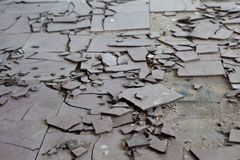Asbestos in the HomeIf you are thinking about starting repairs, maintenance or renovations and your home is pre 2000 you should consider that there may be asbestos in some of the building products you are may be removing. What does it look like? Not all asbestos looks like fluffy insulation or textured ceilings. Asbestos was commonly mixed with other building products meaning it may be present in other building materials, flooring for example. Some products are not a significant risk when they are intact and sealed, however there is a risk that fibres will be released to the air if cutting, scrapping, sawing, stripping and removing materials. Asbestos fibres are a well known health hazard. Health New Zealand Te Whatu Ora also provides information for members of the public. Asbestos containing materials or ACM's come in all shapes, sizes and colours. There are three main types — blue, brown and white asbestos, and all were used in many building products. Asbestos was often mixed with other materials so in many cases it is almost impossible to identify by eye whether or not it is present in suspect materials. The only way to be certain if your home contains asbestos is to have materials sampled and tested in an accredited laboratory. If you are engaging builders and other tradesmen your home becomes a workplace, an asbestos management plan, ideally containing an asbestos register should be provided, your tradesmen may ask you for an asbestos survey or as at least evidence that materials have been tested. You should consider having an asbestos survey completed. We can assist. With the changes to the New Zealand legislation that occured 4th April 2016, new Asbestos Regulations were implemented under the ‘Health and Safety at Work Act 2015. These regulations place a duty under Regulation 11 Duty to Analyse Samples to use an IANZ accredited laboratory to undertake asbestos sample testing. Capital Environmental Services (CES) is an IANZ accredited laboratory that has been accredited since 1996. You can take your own samples - Learn how to take a sample here. Or if you are uncertain or unsure please contact us, and we can come and take a sample for you. The most important risk you should think about is that by disturbing the material to remove a piece for testing, you could be releasing asbestos fibres into the air. If you need assistance, need a survey carried out or a management plan, please send us an email for advice. We will give you call back to discuss or arrange a vist. If you have a removal company carrying out removal works for you, CES can carry out your monitoring and clearance requirements. You should make the decisions about the monitoring and testing requirements and the works should be carried out by someone independent of the removal company. Your removal company should have advised you about what you will need for clearance works. |
||
In recent times earthquakes and legislation changes have resulted in an increasing awareness of asbestos throughout New Zealand. A lot of demolition, repair and strengthening is being carried out and CES believes everyone should have access to information and services that encourage the protection of public health.
We encourage homeowners to take the time and read some of the information on our website, and let us know if theres something missing, or give us a call if you have queries.

 NZ OWNED AND OPERATED
NZ OWNED AND OPERATED The Mesothelioma Centre and Asbestos.com has some great resources which you may find useful.
The Mesothelioma Centre and Asbestos.com has some great resources which you may find useful.